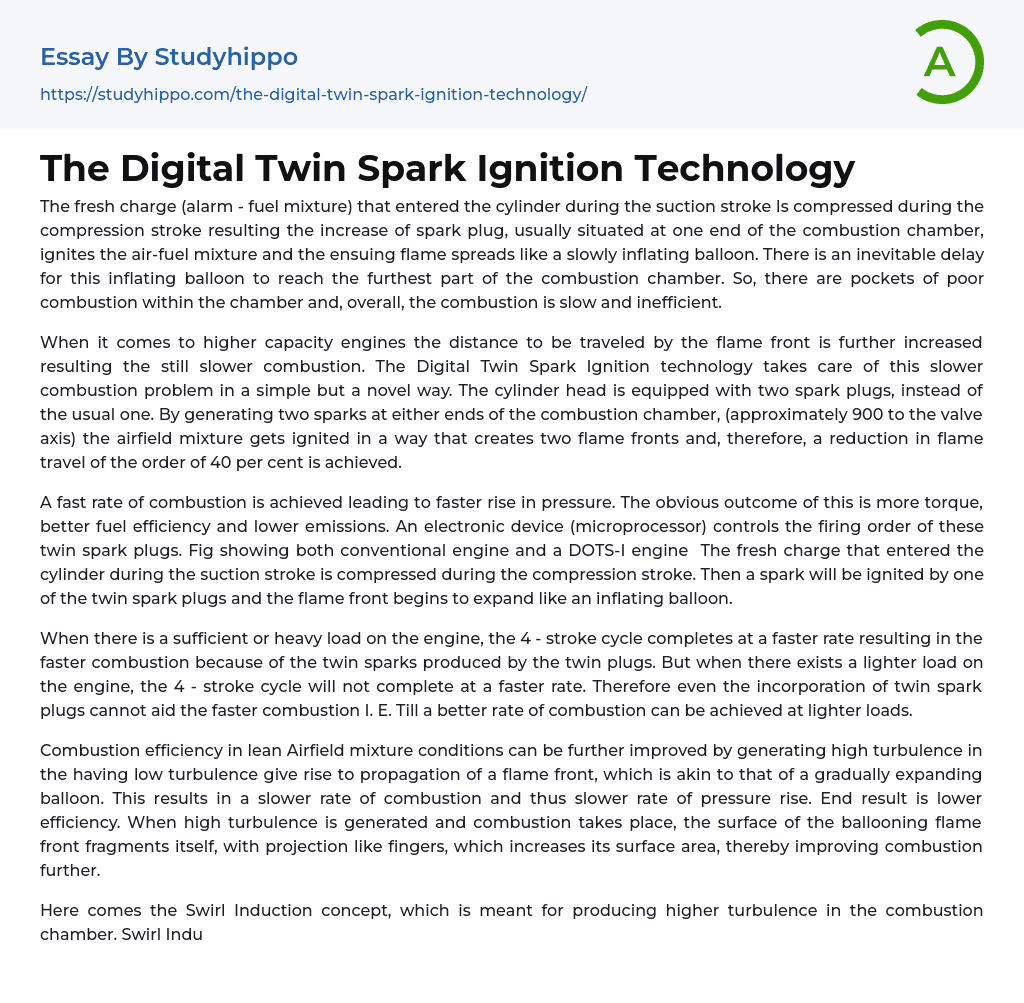The fresh charge (alarm - fuel mixture) that entered the cylinder during the suction stroke Is compressed during the compression stroke resulting the increase of spark plug, usually situated at one end of the combustion chamber, ignites the air-fuel mixture and the ensuing flame spreads like a slowly inflating balloon. There is an inevitable delay for this inflating balloon to reach the furthest part of the combustion chamber. So, there are pockets of poor combustion within the chamber and, overall, the combustion is slow and inefficient.
When it comes to higher capacity engines the distance to be traveled by the flame front is further increased resulting the still slower combustion. The Digital Twin Spark Ignition technology takes care of this slower combustion problem in a simple but a novel way. The cylinder
...head is equipped with two spark plugs, instead of the usual one. By generating two sparks at either ends of the combustion chamber, (approximately 900 to the valve axis) the airfield mixture gets ignited in a way that creates two flame fronts and, therefore, a reduction in flame travel of the order of 40 per cent is achieved.
A fast rate of combustion is achieved leading to faster rise in pressure. The obvious outcome of this is more torque, better fuel efficiency and lower emissions. An electronic device (microprocessor) controls the firing order of these twin spark plugs. Fig showing both conventional engine and a DOTS-I engine The fresh charge that entered the cylinder during the suction stroke is compressed during the compression stroke. Then a spark will be ignited by one of the twin spark plugs and the flame front begins
to expand like an inflating balloon.
When there is a sufficient or heavy load on the engine, the 4 - stroke cycle completes at a faster rate resulting in the faster combustion because of the twin sparks produced by the twin plugs. But when there exists a lighter load on the engine, the 4 - stroke cycle will not complete at a faster rate. Therefore even the incorporation of twin spark plugs cannot aid the faster combustion I. E. Till a better rate of combustion can be achieved at lighter loads.
Combustion efficiency in lean Airfield mixture conditions can be further improved by generating high turbulence in the having low turbulence give rise to propagation of a flame front, which is akin to that of a gradually expanding balloon. This results in a slower rate of combustion and thus slower rate of pressure rise. End result is lower efficiency. When high turbulence is generated and combustion takes place, the surface of the ballooning flame front fragments itself, with projection like fingers, which increases its surface area, thereby improving combustion further.
Here comes the Swirl Induction concept, which is meant for producing higher turbulence in the combustion chamber. Swirl Induction is nothing but imparting a swirling motion to the fresh charge that enters the combustion chamber. This can be done by making slight modifications in the positioning of the ports of engine. The actual DOTS-Is technology: Fig showing both DOTS-I & DOTS-Is engines The DOTS-Is engine will have two spark plugs but it differs from the parent DOTS-I engine in the design of position of the ports.
The straight ports used in conventional engines have limitations
in enervating high swirl values due to their geometry. One of the ways to generate more swirl is to have a port configuration that promotes this phenomena. An offset port configuration was arrived upon and optimized to generate the required swirl numbers. Incorporated in the new engine, this results in a swirling motion of the incoming charge, which decays itself into turbulence as the piston moves in the Induction and Compression strokes.
This results in the Air-Fuel mixture being more thoroughly mixed and spread around the combustion chamber. Sparks provided by the twin spark plugs ignite this highly turbulent and rent with high surface area, resulting in a rapid rise of pressure due to rapid combustion. The values of turbulence achieved now, are substantially higher than that of a straight port cylinder head, such as in DOTS-I. A combination of DOTS-I and Swirl induction thus provides extremely rapid combustion, resulting in high efficiency.
- Energy Development essays
- The elements essays
- Voltage essays
- Solar Energy essays
- Nuclear Energy essays
- Alternative Energy essays
- Electronics essays
- Computer Science essays
- Consumer Electronics essays
- Enterprise Technology essays
- Hardware essays
- Robot essays
- engineering essays
- people search essays
- Modern Technology essays
- Impact of Technology essays
- Cloud Computing essays
- Operating Systems essays
- Information Technology essays
- Data Analysis essays
- Information Age essays
- Smartphone essays
- Cell Phones essays
- Camera essays
- Computer essays
- Ipod essays
- Mobile Phones essays
- 3g essays
- Bluetooth essays
- Cell Phones in School essays
- Computer File essays
- Desktop Computer essays
- Servers essays
- Data collection essays
- Graphic Design essays
- Data Mining essays
- Cryptography essays
- Internet essays
- Network Security essays
- Android essays
- Computer Security essays
- World Wide Web essays
- Website essays
- Computer Network essays
- Application Software essays
- Computer Programming essays
- Computer Software essays
- Benchmark essays
- Information Systems essays
- Email essays




